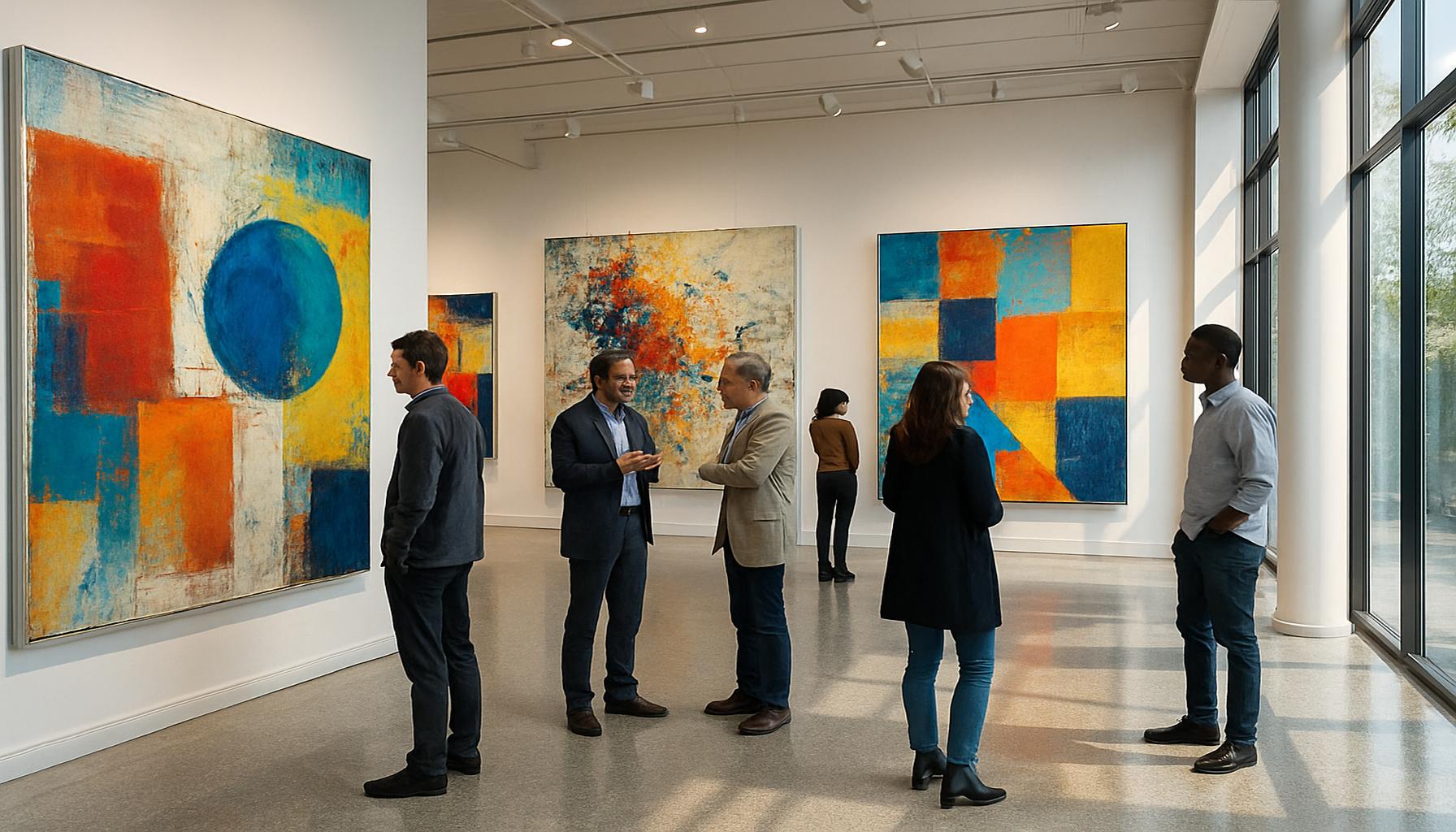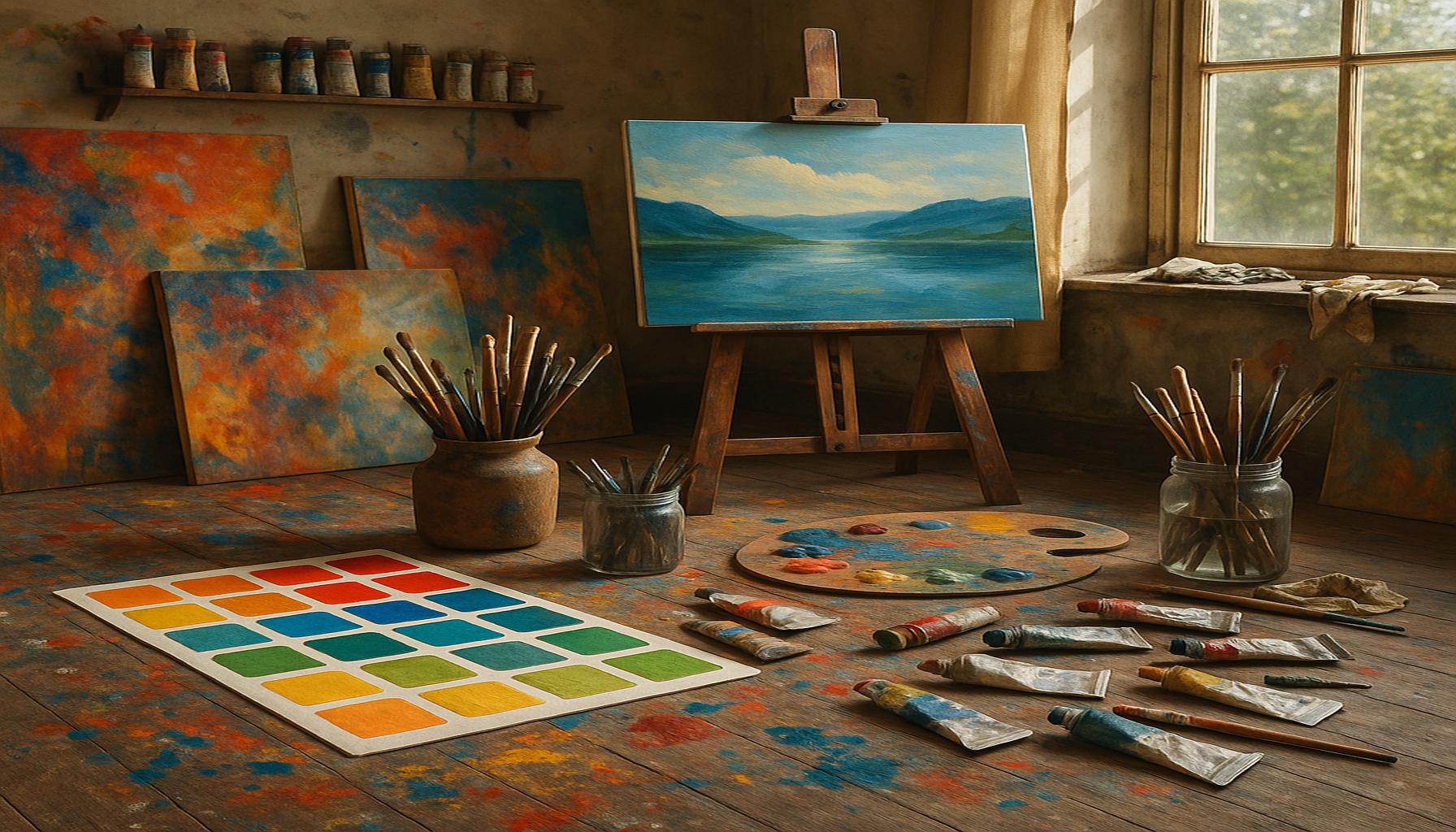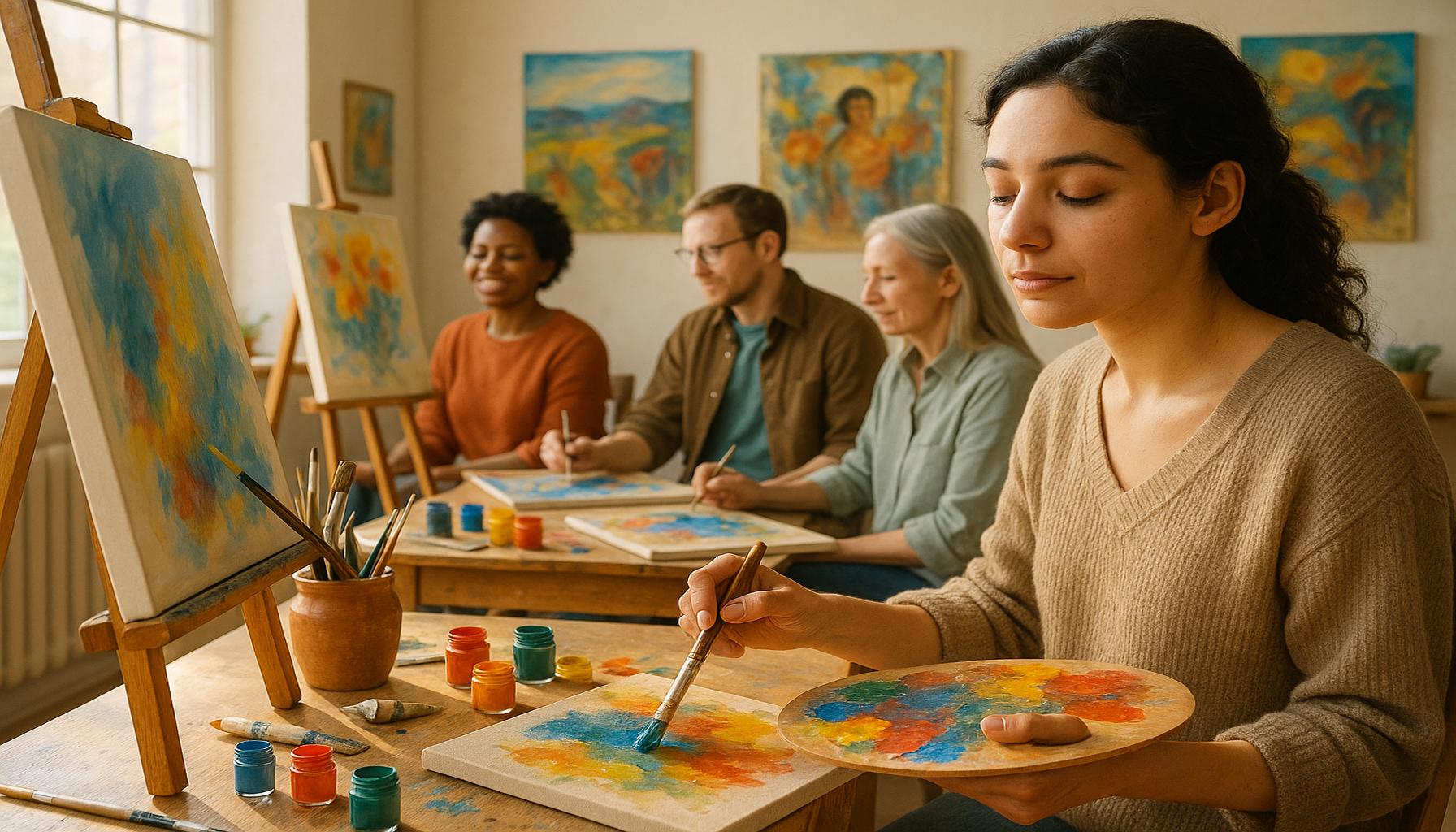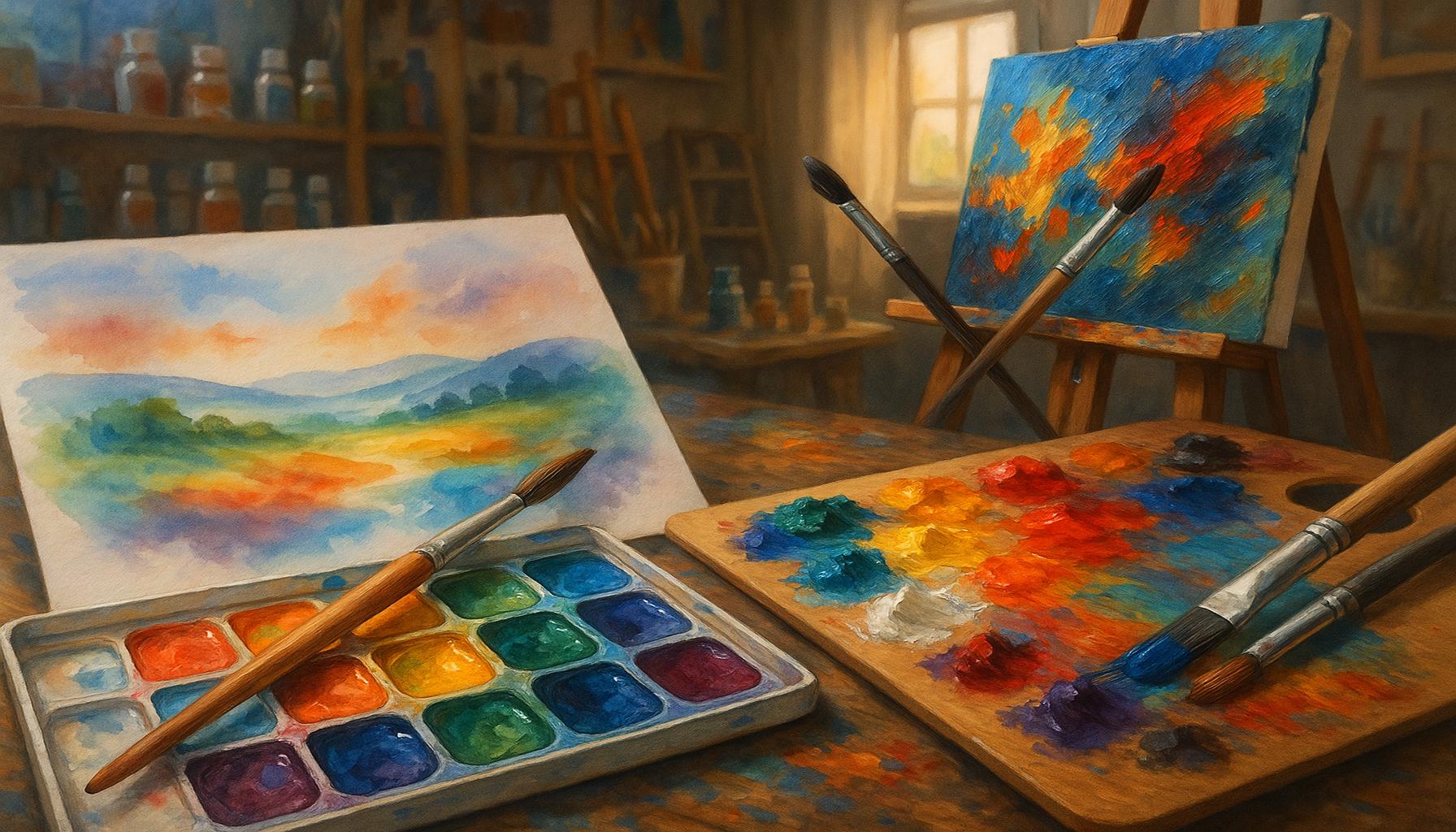The Role of Abstract Art in Modern Painting: Breaking Traditional Boundaries

Understanding the Essence of Abstract Art
Emerging in the early 20th century, abstract art has played a crucial role in redefining the landscape of modern painting. Unlike traditional art forms that sought to mimic reality through representational techniques, abstract art prioritizes the expression of inner feelings, concepts, and experiences through the use of non-representational forms. This shift toward abstraction encourages both artists and viewers to engage with art on a fundamental level, emphasizing the importance of personal interpretation and emotional resonance.
Key to understanding abstract art is its foundational element: the focus on colors, shapes, and lines. For instance, artists such as Wassily Kandinsky and Piet Mondrian utilized geometric shapes coupled with bold, vibrant colors to convey complex ideas and evoke emotions. Kandinsky, one of the pioneers of abstract art, believed that colors could create sounds and feelings, transforming visual experiences into auditory sensations. This deep emotional engagement invites viewers to experience art beyond traditional narratives, allowing them to form unique connections based on their individual interpretations.
- Non-representational forms can take many shapes, from simple geometric patterns to intricate swirls and splatters, as demonstrated in the works of Jackson Pollock.
- The emphasis on emotion is evident in abstract expressionist works, which often reflect the artist’s state of mind, as seen in Mark Rothko’s color field paintings that aim to evoke profound feelings.
- Innovative approaches to using mixed media and unconventional materials further push the boundaries of art. Artists today might incorporate everything from fabric to digital media, showing that the canvas is no longer just a physical surface.
Movements such as Abstract Expressionism and Color Field painting have been instrumental in the evolution of abstract art, transforming how artists approach their craft. Jackson Pollock’s iconic drip paintings, for example, embodied spontaneity and the idea of action painting, where the physical act of creating the artwork is just as significant as the artwork itself. Meanwhile, Mark Rothko’s use of large, luminous blocks of color seeks to communicate emotional depth and existential themes, prompting viewers to reflect on their own experiences and feelings.
The impact of abstract art continues to resonate globally, fostering a dialogue about the shifting role of the artist in contemporary society. As artists navigate between the realms of self-expression and societal commentary, abstract art serves as a mirror reflecting personal and collective experiences in a rapidly changing world.
Through this exploration of abstract art, readers are invited to delve deeper into how this genre has not only challenged historical norms but has also transformed perspectives on what art can be. Its legacy persists, inspiring new generations of artists and viewers alike to engage with art in more profound and meaningful ways.
DIVE DEEPER: Click here to discover the evolution of sculpture
The Evolution of Abstract Art and Its Impact on Modern Painting
The journey of abstract art is intrinsically linked to the broader narrative of modern painting, fundamentally reshaping artistic expression and the viewer’s experience. In the early 20th century, artists began to eschew representational forms, gravitating instead toward abstraction to explore deeper dimensions of creativity and perception. This transition coincided with rapid societal changes brought about by industrialization, globalization, and world conflicts—each uniquely influencing the artistic climate of the time.
As artists sought to articulate the complexities of modern life, they embraced avant-garde practices that broke away from traditional techniques. The adoption of innovative techniques and perspectives enabled artists to challenge established norms. One notable outcome of this artistic revolution was the emergence of various movements within abstract art, each contributing to its rich tapestry. For instance:
- Dadaism: Arising as a reaction to World War I, Dadaism championed chaos and irrationality, encouraging artists to create nonsensical works that rejected conventional aesthetics.
- Futurism: This movement celebrated technology and dynamic movement, emphasizing modernization, speed, and the violence of contemporary life, thus pushing art into uncharted territories.
- Surrealism: Surrealists like Salvador Dalí and Max Ernst incorporated dreamlike imagery and subconscious motifs to conjure a realm beyond immediate reality, fueling the notion that art can transcend the tangible.
The introduction of abstraction not only transformed how artists viewed their work but also significantly altered the role of the viewer. Instead of simply observing a depiction of reality, individuals became active participants, interpreting and finding meaning in the emotive use of color and form. Abstract art unfolded a new realm of visual language where interpretations were subjective, leading to greater personal engagement. This marked a distinct departure from the didactic nature of classical art, which sought to instruct and convey moral lessons.
The significance of abstraction can be further observed in the realm of contemporary artistic movements. Today, artists continue to experiment with the boundaries of abstract expression, fusing traditional techniques with modern technologies. Interactive installations, digital art forms, and even virtual reality experiences all exemplify how abstract art remains a dynamic and evolving canvas. This continual evolution is critical to maintaining its relevance in a society inundated with visual stimuli.
Moreover, abstract art resonates with contemporary issues, often allowing artists to comment on social, political, and environmental themes without relying on tangible representation. It creates a space for dialogues that are not bound by language or cultural context, making it a universal mode of expression.
In understanding the role of abstract art in modern painting, one must appreciate its power to transcend traditional boundaries. It remains a vital part of contemporary discourse, continuously inspiring and prompting fresh perspectives on what art can embody and convey.
The Evolving Landscape of Abstract Art
Abstract art has transcended traditional boundaries established by realism and representation, creating a dynamic dialogue in the art world. Artists like Wassily Kandinsky and Piet Mondrian broke away from conventional forms, introducing shapes, colors, and textures that defy categorization and promote individual interpretation. This movement encourages viewers to engage with art on a deeply personal level, allowing for an emotional connection rather than a purely aesthetic appreciation.
Expression and Emotion
In modern painting, the role of abstract art is paramount in expressing complex emotions and societal challenges. For instance, the works of Jackson Pollock illustrate chaos and spontaneity, reflecting the turbulent post-war society. As such, abstract pieces can serve as mirrors to the context in which they are created, providing insight into cultural and personal narratives.
New Mediums and Techniques
As technology evolves, so does abstract art. Contemporary artists are experimenting with various mediums—from digital art to installation and performance art—pushing the boundaries of traditional painting. This experimentational phase promotes inclusivity by inviting diverse voices and perspectives into the conversation, widening the scope of abstract thinking.
Influence on Popular Culture
Moreover, abstract art influences popular culture, infiltrating design, fashion, and advertising. Brands leverage abstract concepts to evoke feelings or ideas that resonate with consumers, showcasing the versatility of abstract imagery beyond the canvas. This crossover exemplifies that abstract art is not confined to galleries but is integral to everyday life, challenging us to view the world through a different lens.
Global Perspectives
With globalization, the exchange of artistic ideas has enriched the world of abstract art. Artists from diverse backgrounds contribute unique perspectives that reflect their cultural identities. This cross-pollination of ideas fosters an environment where boundaries blur, encouraging an appreciation for the myriad of interpretations that abstract art can offer.
| Category | Details |
|---|---|
| Expression and Emotion | Abstract art allows for a personal emotional journey, encouraging deeper connections with viewers. |
| Cultural Influence | It reflects societal contexts and encourages cultural dialogue. |
Through this lens, abstract art emerges not merely as an aesthetic choice but as a catalyst for critical thought, innovation, and cross-cultural communication. The question remains: how will abstract art continue to challenge our perceptions and redefine the boundaries of modern painting?
DISCOVER MORE: Click here for insights on creative writing and mental wellness
The Intersection of Abstract Art with Other Art Forms
As abstract art continues to evolve, its ability to intersect with various artistic disciplines ignites intriguing dialogues around the essence of creativity. In contemporary society, where cross-disciplinary collaboration is increasingly valued, abstract art emerges as a bridge between different realms of expression. The fusion of abstract art with music, dance, and literature exemplifies how this genre extends beyond the canvas, inviting multifaceted engagement.
One of the most significant examples can be found within synesthesia, where artists and composers work to meld visual and auditory experiences. Musicians like Kandinsky, who believed that colors corresponded to musical notes, laid the groundwork for artists to explore how abstract visuals could provoke auditory sensations. This notion further developed with contemporary performers and visual artists collaborating on multimedia concerts. Works like Jeff Mills’ “Waves” utilize projections of abstract art to create immersive environments where the audience experiences sound and sight simultaneously, thus enhancing the role of abstraction in modern artistic expression.
Beyond auditory explorations, the dance world has also drawn on the principles of abstraction, challenging traditional narrative forms. Choreographers often use abstract movement to convey emotions and themes that defy explicit interpretation. By embodying concepts rather than narrating them, modern dancers break conventional boundaries, using their bodies to interpret abstract ideologies. This movement towards abstraction in dance parallels similar shifts in painting—both strive for a more visceral experience over a clear storyline.
Abstract Art in Digital Mediums
The rise of the digital age catalyzed a revolution in abstract art, pushing traditional boundaries even further. Artists now leverage digital tools to create works that challenge physical limitations. Software like Adobe Creative Suite and open-source platforms empower creators to experiment with shapes, colors, and forms in ways that manual techniques cannot replicate. The proliferation of tools for digital painting and 3D modeling allows artists to push the envelope of their imagination, resulting in works that are often perceived as alerts to the rapid technological advancements surrounding us.
Furthermore, artists are embracing social media platforms as both a platform for sharing their abstract works and as a canvas for creation. Instagram and TikTok foster communities where visual experimentation flourishes, allowing users to engage with abstract art in real-time and share their interpretations with broader audiences. This democratization of art erodes the exclusivity previously associated with traditional art forms, inviting diverse interpretations and promoting accessibility.
The Societal Reflections in Abstract Art
Importantly, abstract art frequently mirrors shifting societal values, allowing artists to reflect on current events and cultural movements without relying on realistic representation. For instance, the rise of anti-establishment sentiments and activism can be found in the works of contemporary abstract artists. Through bold colors, disrupted forms, and chaotic compositions, these artists harness abstraction to communicate complex emotional landscapes related to social unrest, environmental crises, and issues of identity.
Prominent figures like Mark Bradford utilize abstract techniques to comment on racial and socioeconomic issues in America. His large-scale collages reflect the interplay between various cultural elements and historical contexts, shedding light on the intricate narratives that define contemporary society. This overlap emphasizes how abstract art serves as a powerful vehicle for addressing significant cultural conversations, enabling artists to engage with audiences on multiple levels.
As abstract art forges ahead, its capability to adapt and resonate within different contexts secures its place as a crucial component of modern painting, continuing to transcend traditional boundaries while reflecting the complexity of human experience.
DISCOVER MORE: Click here to delve into the world of sustainable sculptures
Conclusion: The Enduring Impact of Abstract Art
In a world increasingly driven by innovation and creative exploration, abstract art stands as a significant force within modern painting, effectively breaking down traditional boundaries and reshaping the landscapes of artistic expression. By embracing non-representational forms, artists challenge not only aesthetic conventions but also the ways in which meaning is conveyed in art. The fusion of abstract works with mediums such as music, dance, and digital technology underscores its adaptive nature and relevance in today’s multifaceted cultural dialogues.
Through the lens of abstract art, we find reflections of societal shifts and the complexities of modern life. Artists like Mark Bradford, in addressing themes such as identity and social justice, transform their canvases into powerful commentaries on the human experience. This remarkable ability to convey intricate narratives without traditional representation invites viewers to engage in more profound conversations about culture, identity, and emotion.
Moreover, the accessibility afforded by digital mediums and social media platforms fosters an inclusive art culture that encourages experimentation and diverse interpretations, ensuring that abstract art remains a dynamic, evolving genre. As we continue to analyze and appreciate the role of abstract art in modern painting, it becomes clear that its significance lies not merely in its visual appeal but in its capacity to challenge perceptions, provoke thought, and inspire dialogue. For those interested in the ongoing impact of art on society, further exploration of abstract art promises to reveal deeper insights into the connections between creativity and the human condition.



